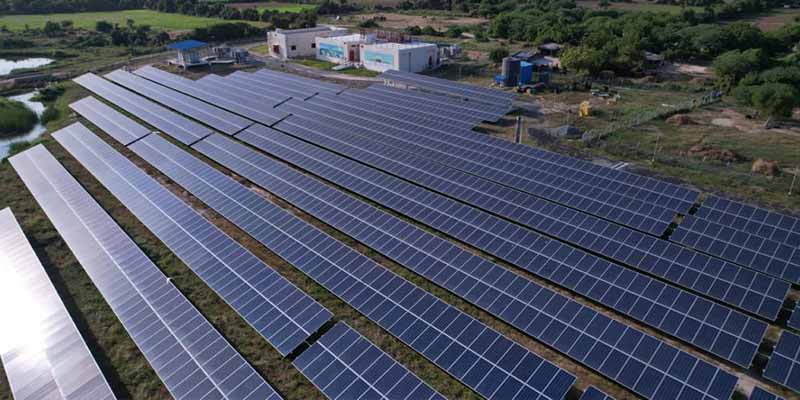- India
- Oct 10
PM Modi declares Modhera as India’s first 24x7 solar-powered village
• Prime Minister Narendra Modi declared Modhera in Gujarat’s Mehsana district as India's first 24x7 solar-powered village.
• Modhera is famous for a centuries-old Sun temple built during the Chalukya reign. It was built by King Bhima I of the Chalukya dynasty.
• The village is located on the banks of the Pushpavati river in the state.
• Making Modhera the country’s first round-the-clock solar-powered village involved developing a ground-mounted solar power plant and more than 1,300 rooftop solar systems on residential and government buildings, all integrated with Battery Energy storage system (BESS).
• The central and state governments have invested over Rs 80 crore in this solar-development project in two phases.
National Solar Mission
• A total of 152.90 GW of renewable energy capacity projects (including large hydro) have been installed in the country as on February 28, 2022 which includes 50.78 GW from solar power.
• India is endowed with vast solar energy potential. About 5,000 trillion kWh per year energy is incident over India's land area with most parts receiving 4-7 kWh per sq. m per day. Solar photovoltaics power can effectively be harnessed providing huge scalability in India.
• The country has an estimated solar energy potential of about 750 GW solar power.
• Solar also provides the ability to generate power on a distributed basis and enables rapid capacity addition with short lead times. Off-grid decentralised and low-temperature applications will be advantageous from a rural electrification perspective and meeting other energy needs for power and heating and cooling in both rural and urban areas.
• There has been a visible impact of solar energy in the Indian energy scenario during the last few years. Solar energy based decentralised and distributed applications have benefited millions of people in Indian villages by meeting their cooking, lighting and other energy needs in an environment friendly manner.
• The social and economic benefits include reduction in drudgery among rural women and girls engaged in the collection of fuel wood from long distances and cooking in smoky kitchens, minimisation of the risks of contracting lung and eye ailments, employment generation at village level, and ultimately, the improvement in the standard of living and creation of opportunity for economic activities at village level.
• Further, solar energy sector in India has emerged as a significant player in the grid connected power generation capacity over the years. It supports the government agenda of sustainable growth, while emerging as an integral part of the solution to meet the nation’s energy needs and an essential player for energy security.
• Solar energy has taken a central place in India's National Action Plan on Climate Change with the National Solar Mission as one of the key Missions.
• The National Solar Mission (NSM), launched on January 11, 2010, with the objective of establishing India as a global leader in solar energy, by creating the policy conditions for solar technology diffusion across the country as quickly as possible.
• It will also constitute a major contribution by India to the global effort to meet the challenges of climate change. The Mission’s objective is to establish India as a global leader in solar energy by creating the policy conditions for solar technology diffusion across the country as quickly as possible.
Some major schemes
Pradhan Mantri Kisan Urja Suraksha Evam Utthan Mahabhiyan (PM KUSUM)
PM-KUSUM scheme is one of the largest initiatives in the world to provide clean energy to more than 3.5 million farmers by solarising their agriculture pumps. PM-KUSUM scheme aims to install grid connected ground mounted solar power plants (up to 2 MW) aggregating to a total capacity of 10 GW under Component A, install 20 lakh standalone solar pumps under Component B, and solarise 15 lakh grid connected agricultural pumps under Component C. All components combined would support installation of additional solar capacity of 30.80 GW.
Roof Top Solar (RTS) Programme
Rooftop Phase-I of this programme was launched on December 30, 2015 in which incentives and subsidies were provided for residential, institutional and social sectors. For the government sector, achievement linked incentives were also provided. Rooftop Phase-II was launched in February 2019 with a target of achieving cumulative capacity of 40,000 MW by the year 2022.
Solar Parks
The ministry introduced the Solar Parks Programme with the objective of facilitating solar project developers to set up projects in a plug-and-play model. The scheme for development of solar parks has a target capacity of 40 GW. All states and Union Territories are eligible for getting benefits under the scheme.
Green Energy Corridors
To facilitate evacuation of electricity from renewable energy projects, Green Energy Corridor scheme was launched in 2015 for setting up of transmission and evacuation infrastructure. The Inter-State Transmission System (ISTS) component consisting of 3,200 ckm transmission lines and 17,000 MVA sub-stations was completed in March 2020.
Manorama Yearbook app is now available on Google Play Store and iOS App Store


